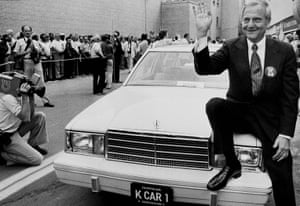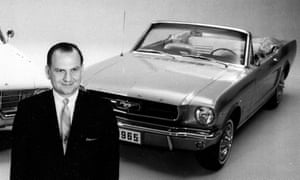US motor industry leader who launched the Ford Mustang and turned around the fortunes of Chrysler

Lee Iacocca at the launch of the Chrysler K-Car, in Detroit, in 1980. He appeared in ads for the car, with the line ‘If you can find a better car, buy it.’
Photograph: Dale Atkins/AP
At the height of his career, Lee Iacocca, who has died aged 94, was one of the most powerful and celebrated of US business leaders and, as the son of Italian immigrants, the embodiment of all the possibilities of the great American dream. As the creator of the spectacularly successful 1964 Ford Mustang, he had his first taste of fame aged 39 when both Time magazine and Newsweek put his face – alongside the new car – on their front covers.
Six years later he was made president of Ford, the motor company he had worked for since 1946, and already had a high enough profile to feature on the list of celebrities the cult leader Charles Manson planned to kill. The cruelly public manner of Iacocca’s undermining and dismissal by Henry Ford II in 1978 made headlines almost as big; particularly since Iacocca had put the Ford Motor Company $2bn into the black that year, despite presiding over an increasingly out-of-touch range of cars and ever more pressure from Japanese and European imports.
For Iacocca this was a personal trauma matched only by his childhood memories of the Depression and its effects on his hard-working parents, Antonietta (nee Perrotta) and Nicola Iacocca. “The Depression turned me into a materialist,” he wrote in his bestselling autobiography, Iacocca (1984). “Years later, when I graduated from college, my attitude was: ‘Don’t bother me with philosophy. I want to make ten thousand a year by the time I’m 25, and then I want to be a millionaire.’ I wasn’t interested in a snob degree; I was after the bucks.”
Two weeks after his humiliating departure from Ford, Iacocca took on the presidency of the ailing Chrysler Corporation, weakest of the American motor industry “big three”. By cutting its workforce and rationalising its product range (with smaller, more efficient models such as the Mini Van and front-wheel-drive K-Car concepts that Henry Ford had refused to sanction), Iacocca was able to turn Chrysler’s fortunes around. By the early 80s, he was even able to pay back the huge government-guaranteed loans used to fund the restructuring of the company, seven years ahead of schedule.
His starring role in the TV ads for the “European-sized” K-Car (“If you can find a better car, buy it” was his famous pay-off line) made him one of America’s most recognisable businessmen, and the success of the new models added lustre to Iacocca’s reputation as the ultimate “comeback kid” and the most resilient figure in a brutally tough industry.

Lido “Lee” Iacocca was born and brought up in Allentown, in the Pennsylvania steel belt. His father had landed as an immigrant at Ellis Island in 1902 and at the time of Lee’s birth was the owner of a successful hot dog restaurant, with a streetwise business sense that the young Lee inherited. The family was close and loving, and Lee was a bright student.
A childhood bout of rheumatic fever spared him from call-up in the aftermath of Pearl Harbor, and after graduating in engineering from Lehigh University in Bethlehem, Pennsylvania, Iacocca joined Ford in 1946 at its River Rouge plant at Dearborn, Michigan. At that time the founder of the company, the first Henry Ford, was still alive. It was very much a family business; Henry Ford II never tired of reminding Iacocca that it was “my name on the front of the building”.
Iacocca soon realised his future lay in sales and the marketing of automobiles rather than the designing of them. He proved himself a success selling Ford trucks in New York and rose quickly through the hierarchy. He was assistant general sales manager of Ford’s Philadelphia district when his slick “56 for 56” finance promotion ($56 a month over three years) got him noticed by the Dearborn executives. It was estimated by his boss, Robert McNamara, vice-president of the Ford division and future defence secretary in the Kennedy administration – to have helped shift an additional 75,000 Fords in the not-very-popular 1956 range. In 1960 Iacocca was made general manager of Ford division, the biggest division in the world’s second largest company.
The Mustang was born out of recognition that the market was changing and that there was a pent-up demand for a smaller, sportier car for a generation of postwar baby boomers who wanted a practical sports car with four seats. Demographics were analysed and suggested that the average age of the population was falling and that a younger, better educated generation of buyers was increasingly in the market for a second car that was almost always smaller and sportier. Here, for once, was a market looking for a car, rather than the other way around.
There was no money to create an all-new car, so the Mustang – developed for a relatively modest $75m – was designed around the basic Ford Falcon compact, reskinned with a handsome long nose/short tail body. It had strong overtones of European sophistication when most American cars were still big, flabby horrors.
It was not christened Mustang until relatively close to its debut at the World’s Fair in 1964, but at a basic price of well under $2,500 it probably would not have mattered what it was called. American car buyers, worked into a frenzy by a slick marketing campaign, went mad for the Mustang, seduced by its styling, its youthful flavour and a bewildering range of options that meant it was possible to specify a personal vehicle. Most buyers spent a further $1,000 on extras such as V8 engines, automatic transmission and sportier seats.
Ford dealerships were mobbed by buyers in scenes reminiscent of Beatlemania, in the first weeks after the Mustang was released. Sales of nearly 420,000 in the first year far outstripped even Iacocca’s expectations, and two additional Mustang assembly plants had to be built to keep up with demand. In the first two years alone the Mustang generated $1.1bn in net profits. The Mustang begat the Mercury Cougar and a whole slew of copycat “pony cars” from Ford’s arch-rival General Motors. Meanwhile, Iacocca turned his attention to Ford’s ailing Lincoln-Mercury division and revitalised its fortunes with the spectacularly cheesy 1968 Continental Mark III, complete with a faux Rolls-Royce grille and a Cartier dashboard clock.
Two years later the Ford Pinto, a “subcompact” designed under Iacocca’s watch, became a public relations disaster when it was discovered that the position of its fuel tank made it likely to catch fire in a rear-end impact. Many did, with fatal results. A safety recall was not instigated until two years after the car went out of production. Iacocca, a master of cost-cutting, rejected claims that he had calculated it would be cheaper to fight lawsuits than re-engineer the Pinto, which in any case was a wheezing runabout and is still regularly shortlisted for the title of “all-time worst car”.
After retiring from Chrysler in 1992, Iacocca focused on his business interests and charitable works, particularly the funding of research into diabetes.
Iacocca married Mary McCleary in 1956; she died of complications of diabetes in 1983. He is survived by their daughters, Kathryn and Lia. Two further marriages ended in divorce.
• Lido Anthony Iacocca, businessman, born 15 October 1924; died 2 July 2019